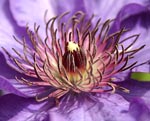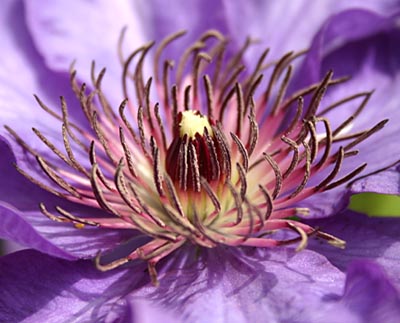Buy plants for springtime scent
You can buy some wonderful plants with diverse scents for the garden


** If you want to buy any of the plants mentioned below for your own garden, visit www.countrylife.co.uk/nursery
and type or copy and paste the name into the search. Plants are
delivered in sturdy boxes in a matter of days from one of the finest
nurseries in the country. **
On warm afternoons in March and April, an enticing scent wafts over a college wall here in Oxford and stops passing tourists in their tracks. Some of them sniff, and decide a little cocoa would be just the ticket, but few realise that their phantom chocolatier is, in fact, a woody semi-evergreen twiner from the Far East.
Akebia quinata is hardy and easily pleased, growing fast and throwing out a multitude of slender stems each season. Its trim, five-lobed leaves sometimes turn to plum in an Indian summer, but they're at their loveliest now, unfolding in a grasshopper green whose freshness offsets the intensity of the flowers. These are scented not of any old newsagent's chocolate, but of Michelin-grade ganache. They hang, large female flowers with smaller males, in trusses like miniature bunches of grapes, and are wine-red to deep maroon, not unlike that other chocolatier Cosmos atrosanguineus. There are also forms in greyish lilac, faded crimson and white, and two-tones, such as Amethyst Glow, with puce female blooms and coral males.
A. quinata tends to be planted in unloved, often shady, spots where its overreaching won't matter. There, it grows prodigi-ously, but flowers poorly or beyond range of our senses. Akebia trifoliata, its coarser cousin, would be a better choice for such sites and for clothing tree trunks and concealing eyesores.
Sign up for the Country Life Newsletter
Exquisite houses, the beauty of Nature, and how to get the most from your life, straight to your inbox.
Plant A. quinata on a wall or pergola, where spring sunshine can elicit its perfume and you can get close to it. Give it a companion capable of complementing its chocolate drops-one of the larger Alpina-type (Atragene Group) clematises, such as the azure C. Frances Rivis, or a white wisteria. Once this duet has finished flowering, get tough. Cut out tired old tangles and wayward whips, reducing the Akebia to a manageable framework. In the months ahead, it will produce more shoots, the strongest of which you should keep and train, trimming their tips to promote branching. But, after high summer, tuck and tie in rather than prune it or you'll be cutting off next season's flowers.
Akebia belongs to an enigmatic plant family, the Lardiza-balaceae-a splendidly drawling name that commemorates Miguel Lardizábal y Uribe, an 18th-century Mexican-born Spanish politician and botanophile. Most of its horticultural members are Asian and they're becoming more frequent in English gardens. After Akebia, the two most fami-liar genera are Stauntonia and Holboellia. Hardy evergreen climbers are in short supply, and these two would be invaluable for their lustrous palmate leaves alone.
Their flowers are a delicious bonus: starry or bluebell-like in shape and also tourist-arrestingly fragrant. Unlike Akebia, they prefer some protection from scorching sun and wind, and a damp, neutral to acid soil that's rich in humus. They're ideal for walls and pergolas in gardens where their sleek year-round luxuriance won't be incongruous.

Stauntonia hexaphylla is my least favourite: it looks like the office Schefflera on speed, becomes leggy and gappy, and sulks in cold years. Holboellia is more obliging-it's hardier, with smaller and denser leaves and cascades of blooms from mid spring onwards. H. coriacea and H. latifolia are the toughest species, with swags of glittering dark green foliage and vanilla-scented flowers that range from lime to cream, rosy buff, lilac-mauve and ruby. As with Akebia, different sexes of flower (both on the same plant) will be of different shapes, sizes and hues.
There are also selections, such as the purple-tinted H. coriacea Cathedral Gem, discovered on a wall at Winchester Cathedral. Bleddyn Wynn-Jones of Crûg Farm Plants (www.crug-farm.co.uk) has travelled somewhat further afield in search of new Lardizabs. His Far Eastern intro-ductions include richly coloured forms of the two Holboellia species I've mentioned and dazzling newcomers such as H. brachyandra (hardy in a sheltered spot), whose alabaster blooms are the largest in the genus.
All of these produce bean-like fruit, sometimes palatable, often in vivid colours, but they do so begrudgingly in our climate. One of their kin, however, will crop dependably: Decaisnea fargesii, a bandy-legged deciduous shrub, non-climbing and not, in my view, remotely edible. Why grow it? Because its beans are the most bizarrely ornamental fruit of any hardy garden plant. They are electric-blue sausages, hanging in links all autumn long. It's a strange family, the Lardiza-balaceae, and underrated.
Country Life is unlike any other magazine: the only glossy weekly on the newsstand and the only magazine that has been guest-edited by HRH The King not once, but twice. It is a celebration of modern rural life and all its diverse joys and pleasures — that was first published in Queen Victoria's Diamond Jubilee year. Our eclectic mixture of witty and informative content — from the most up-to-date property news and commentary and a coveted glimpse inside some of the UK's best houses and gardens, to gardening, the arts and interior design, written by experts in their field — still cannot be found in print or online, anywhere else.
-
 380 acres and 90 bedrooms on the £25m private island being sold by one of Britain's top music producers
380 acres and 90 bedrooms on the £25m private island being sold by one of Britain's top music producersStormzy, Rihanna and the Rolling Stones are just a part of the story at Osea Island, a dot on the map in the seas off Essex.
By Lotte Brundle
-
 'A delicious chance to step back in time and bask in the best of Britain': An insider's guide to The Season
'A delicious chance to step back in time and bask in the best of Britain': An insider's guide to The SeasonHere's how to navigate this summer's top events in style, from those who know best.
By Madeleine Silver